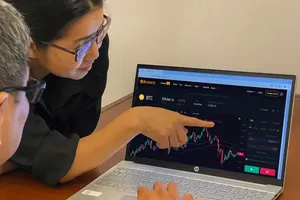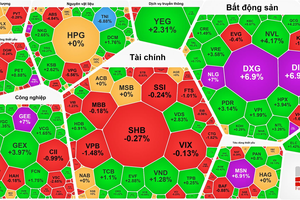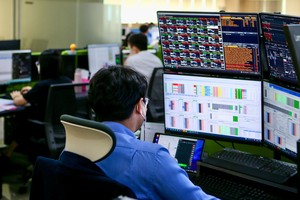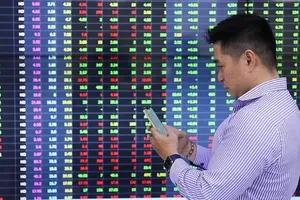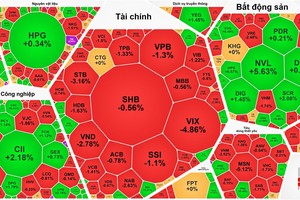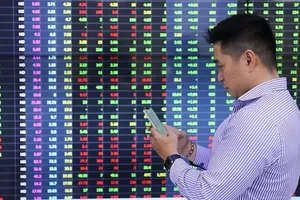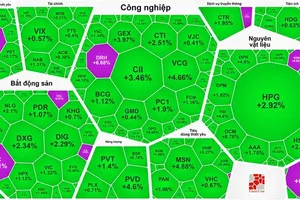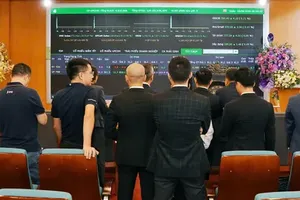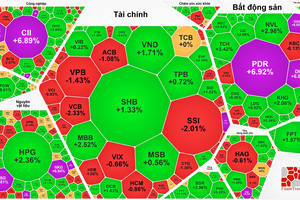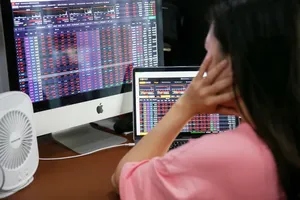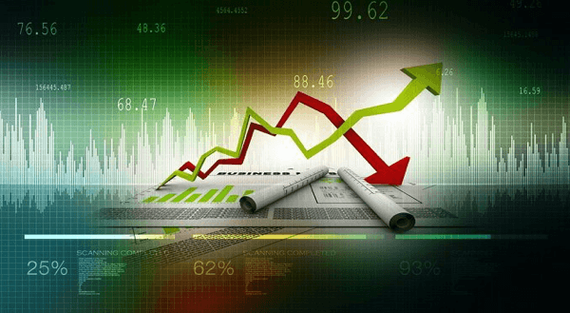 Illustrative photo.
Illustrative photo.
In June 2022, global investors were startled with the record Consumer Price Index (CPI) data of the US at 9.1 percent, that was published in early July. Stock markets in other countries hit bottom then went up, which proved to be reasonable with the cooled down July CPI data published on August 11.
Vietnam stock market
If we consider the stock market which is represented by the indexes as the test chart of the economy, perhaps the VN-Index will have trouble reflecting too much concern. The world oil price reached a five-month peak in the first week of June 2022, and the S&P 500 Index representing the US stock market hit bottom on June 16, 2022. The VN-Index bottomed on July 6, 2022, and since then the S&P 500 Index is up 12.4 percent while the VN-Index is up about 9.3 percent.
Vietnam's macro figures are completely different from many other countries when maintaining a very positive stability. The July CPI increased by 3.14 percent over the same period, an increase by 3.59 percent compared to December 2021, and the seven-month average inflation was controlled at 2.54 percent, which was still not too much of a concern compared to the Government target of 4 percent for 2022.
The current biggest pressure on inflation is the price of energy, while the world oil price has dropped much lower than the threshold of US$100 per barrel. The price of basic materials is also falling sharply, as the domestic construction steel price has experienced the 13th consecutive adjustment since May 2022. Domestic gasoline prices also decreased continuously when tax reduction measures were implemented. If the world oil price continues to be as weak as it is now or drops below, then there is room for a sharper drop in gasoline prices.
The tight control of credit growth makes inflationary pressure in Vietnam less affected by monetary factors, but mainly by cost-push factors. This is to say that world prices of imported goods or other factors have had a knock-on effect on other basic goods in the country. Therefore, when world commodity prices decrease, this pressure also decreases. Of course, there will still be a certain lag, for instance in the price of animal feed, although the world corn price has peaked since the beginning of May 2022 and decreased by up to 23 percent compared to the peak. However, the domestic animal feed price is still very high due to the high cost of imported raw materials. This downtrend in raw material prices, once formed, will sooner or later reflect on the final product prices.
Vietnam's 2022 inflation control task is still considered feasible by international and domestic organizations. This is mainly signaling a cooling down of global goods. This is an expectation that Vietnam's stock market has not really reflected on. The reason is partly due to the large loss in the second quarter for a majority of investors, as well as the limitation of cash flow compared to the previous period. However, if we look from afar, when the macro economy is stable, growth is high and interest rates are still low. It is now the premise of the stock market to continue the trend of healing the wounds of the second quarter.
Commodity price cycle
For investors who have experienced the boom period of 2020 and 2021 and in the first quarter of 2022, the most noticeable difference in the market during this period was the rotation of stocks in different industry groups. There is no longer a situation where stocks increase in price at the same time and investors keep holding a few familiar codes to get good profits.
Misallocation of capital and choosing stocks without understanding the new characteristics of the market will easily lead to loss or capital accumulation. Such is the case of the basic commodity stocks in bull and down cycles such as steel, coal, animal feed, oil, and gas. The diverging stock price cycles are the result of world price fluctuations. When steel prices skyrocketed, construction stocks retreated, but steel stocks flourished. Only when investors understand the commodity price cycle can they optimize cash flow and seek the best profits when investing in this stock rotation strategy.
Geopolitical factors are being felt for the first time, such as on food prices, including animal feed, oil, and coal prices, which have changed dramatically since the Russia-Ukraine conflict. Therefore, the progress or decline of this ongoing conflict will be immediately reflected on stocks in the Vietnamese market. Also, the shortage of gas and fuel will lead to high inflation in Europe and the US, and seriously affect the consumption demand of the local people. This will also affect the export capacity of Vietnamese enterprises, with stock prices facing the brunt.
Another big change will be the cash flow in the stock market. For instance, a large amount of capital from the issuance of real estate bonds, or idle money in businesses that was put into the stock market by many businesses during the period of 2020 to 2021 has already flowed out elsewhere.
In other words, the strategy and capacity of investors is being tested when it is necessary to have a much broader view than basic numbers such as Price Earnings (P/E) ratio or quarterly profits. The variables of the input to each investment strategy are also easy to change, as oil prices could return to a strong uptrend if there is any move to increase supply. At that time, assumptions about reducing inflationary pressure will no longer exist. The recession risk in Europe and the US, which are important export areas for Vietnam, will also be factors that the market can reflect on in advance.
Vietnam stock market
If we consider the stock market which is represented by the indexes as the test chart of the economy, perhaps the VN-Index will have trouble reflecting too much concern. The world oil price reached a five-month peak in the first week of June 2022, and the S&P 500 Index representing the US stock market hit bottom on June 16, 2022. The VN-Index bottomed on July 6, 2022, and since then the S&P 500 Index is up 12.4 percent while the VN-Index is up about 9.3 percent.
Vietnam's macro figures are completely different from many other countries when maintaining a very positive stability. The July CPI increased by 3.14 percent over the same period, an increase by 3.59 percent compared to December 2021, and the seven-month average inflation was controlled at 2.54 percent, which was still not too much of a concern compared to the Government target of 4 percent for 2022.
The current biggest pressure on inflation is the price of energy, while the world oil price has dropped much lower than the threshold of US$100 per barrel. The price of basic materials is also falling sharply, as the domestic construction steel price has experienced the 13th consecutive adjustment since May 2022. Domestic gasoline prices also decreased continuously when tax reduction measures were implemented. If the world oil price continues to be as weak as it is now or drops below, then there is room for a sharper drop in gasoline prices.
The tight control of credit growth makes inflationary pressure in Vietnam less affected by monetary factors, but mainly by cost-push factors. This is to say that world prices of imported goods or other factors have had a knock-on effect on other basic goods in the country. Therefore, when world commodity prices decrease, this pressure also decreases. Of course, there will still be a certain lag, for instance in the price of animal feed, although the world corn price has peaked since the beginning of May 2022 and decreased by up to 23 percent compared to the peak. However, the domestic animal feed price is still very high due to the high cost of imported raw materials. This downtrend in raw material prices, once formed, will sooner or later reflect on the final product prices.
Vietnam's 2022 inflation control task is still considered feasible by international and domestic organizations. This is mainly signaling a cooling down of global goods. This is an expectation that Vietnam's stock market has not really reflected on. The reason is partly due to the large loss in the second quarter for a majority of investors, as well as the limitation of cash flow compared to the previous period. However, if we look from afar, when the macro economy is stable, growth is high and interest rates are still low. It is now the premise of the stock market to continue the trend of healing the wounds of the second quarter.
Commodity price cycle
For investors who have experienced the boom period of 2020 and 2021 and in the first quarter of 2022, the most noticeable difference in the market during this period was the rotation of stocks in different industry groups. There is no longer a situation where stocks increase in price at the same time and investors keep holding a few familiar codes to get good profits.
Misallocation of capital and choosing stocks without understanding the new characteristics of the market will easily lead to loss or capital accumulation. Such is the case of the basic commodity stocks in bull and down cycles such as steel, coal, animal feed, oil, and gas. The diverging stock price cycles are the result of world price fluctuations. When steel prices skyrocketed, construction stocks retreated, but steel stocks flourished. Only when investors understand the commodity price cycle can they optimize cash flow and seek the best profits when investing in this stock rotation strategy.
Geopolitical factors are being felt for the first time, such as on food prices, including animal feed, oil, and coal prices, which have changed dramatically since the Russia-Ukraine conflict. Therefore, the progress or decline of this ongoing conflict will be immediately reflected on stocks in the Vietnamese market. Also, the shortage of gas and fuel will lead to high inflation in Europe and the US, and seriously affect the consumption demand of the local people. This will also affect the export capacity of Vietnamese enterprises, with stock prices facing the brunt.
Another big change will be the cash flow in the stock market. For instance, a large amount of capital from the issuance of real estate bonds, or idle money in businesses that was put into the stock market by many businesses during the period of 2020 to 2021 has already flowed out elsewhere.
In other words, the strategy and capacity of investors is being tested when it is necessary to have a much broader view than basic numbers such as Price Earnings (P/E) ratio or quarterly profits. The variables of the input to each investment strategy are also easy to change, as oil prices could return to a strong uptrend if there is any move to increase supply. At that time, assumptions about reducing inflationary pressure will no longer exist. The recession risk in Europe and the US, which are important export areas for Vietnam, will also be factors that the market can reflect on in advance.


